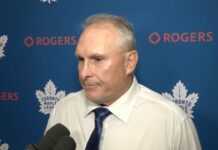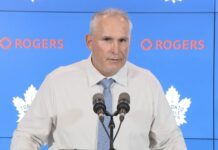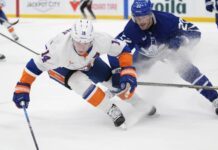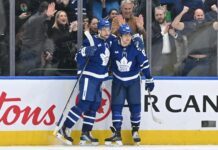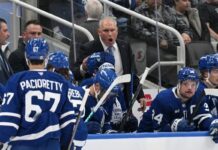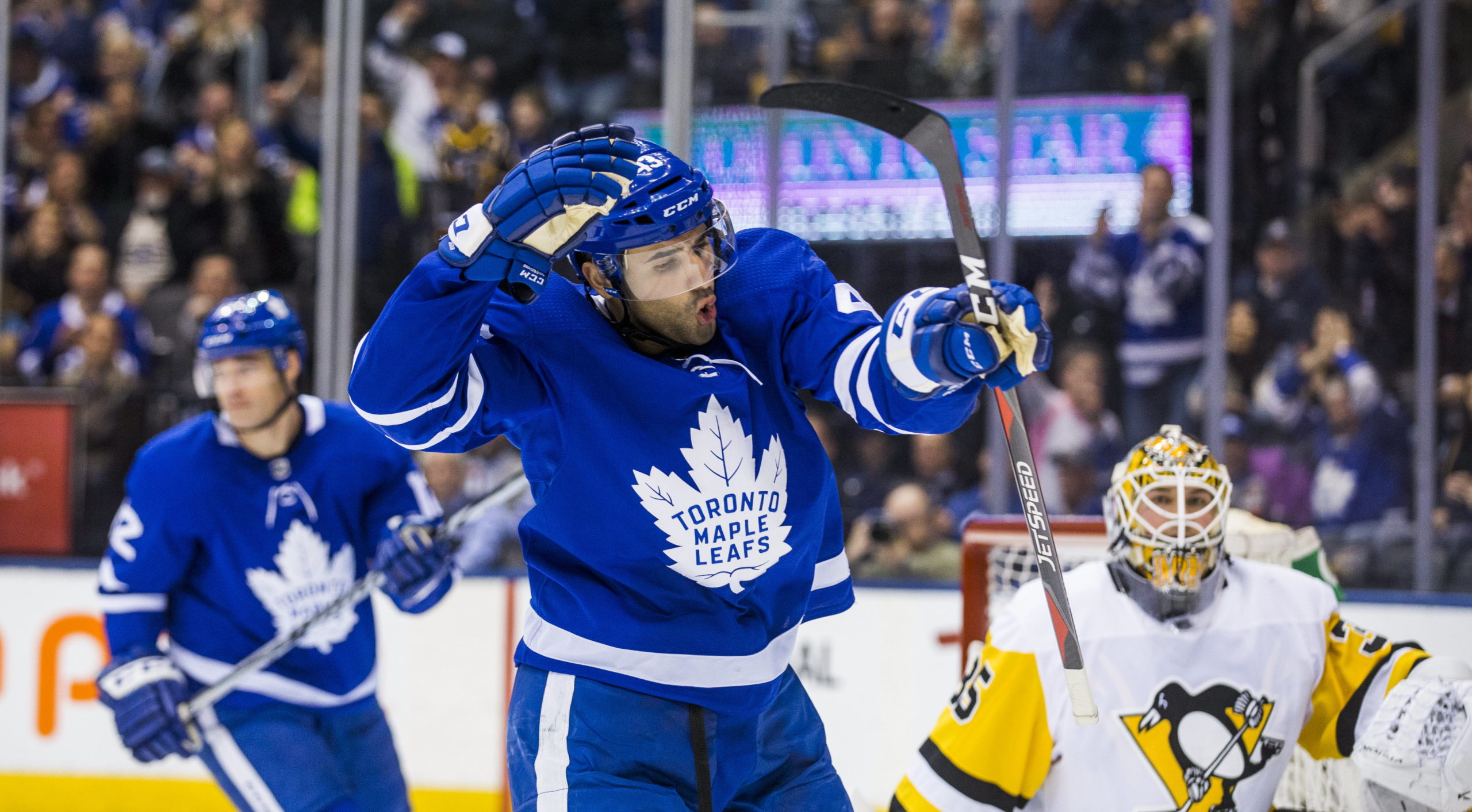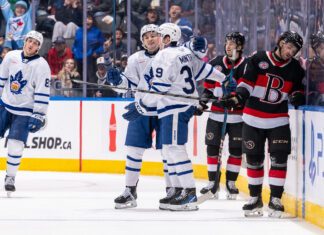Leading up to the NHL Draft, I will be reviewing all aspects of the Toronto Maple Leafs 2018-19 season. Part Two will take a look at Nazem Kadri, William Nylander, and address some of the recent trade rumours.
In case you missed it, here’s part one of my season review/offseason preview series:
Before getting into Part Two, I wanted to follow up on Part One to some degree. Now that the Bruins are in the Cup Final, there seems to be a different tone towards the Leafs that generally falls along the following lines:
- This was a missed opportunity
- That was a first-round series that was more like a third-round series
I’ve been getting asked if I’d change anything that I wrote so far regarding next steps and areas of improvement; the short answer is no. I accounted for how good the Bruins are almost immediately in the article, noting:
The Leafs lost in seven games to a team that tied for the second most regular-season points in a year where every division winner lost in the first round (because the playoffs are hard!), and yet there was a somewhat surprisingly loud chorus of calls for Babcock’s head.
Toronto’s defense still needs work, although it did show signs of improvement this season. Their bottom two lines still need work and the solutions are unclear at this time – in particular, neither of their bottom two lines possesses reliable penalty killers and neither is a unit you would trust in a defensive-zone faceoff role, which in turn would free up Auston Matthews and John Tavares for more offensive opportunities.
The current expectation is Tampa Bay will come back with a vengeance next year and possibly Pittsburgh and Washington, too. The Florida Panthers are an under-the-radar team that could cause trouble next season if they get the free agents many seem to think they will (along with already hiring Joel Quenneville). It’s not good enough to say that the Leafs almost beat Boston. They’re going to have to improve. Management is well aware of that.
Without further ado, let’s get into the review.
Nazem Kadri
Going into the season, Nazem Kadri was, at least in Toronto, named the best third-line center in the league after the Leafs signed Tavares to bump him down the line-up. The Leafs forward group was celebrated for its overall depth, but it was unclear at that time what exactly Kadri’s role would be.
Ultimately, Kadri ended up in a soft scoring role on the third line, with first unit power play time to go along with it. His 16 goals were the fewest in a full season in his career while his 39 points were the second fewest. It all culminated in a season-ending suspension.
What happened here? Let’s take a deeper look.
The soft scoring role never seemed right for Kadri from the start. He was moved up to 2C for a very brief stint when Auston Matthews was hurt. In the 14 games Matthews missed, plus the game he got hurt in (he played under eight minutes and then Kadri was bumped up the lineup), he scored six goals, 10 points, and put 38 shots on net while playing primarily with Mitch Marner.
| Nazem Kadri | Goals per game | Points per game | Shots per game |
|---|---|---|---|
| Without Matthews | .4 | .67 | 2.5 |
| With Matthews | .17 | .59 | 2.5 |
Naturally, with more ice time, you’d expect him to produce more. Let’s look at his rate stats the last three years at even strength:
| G/60 | A/60 | PTS/60 | |
|---|---|---|---|
| 2016 – 2017 | 1.1 | 1.2 | 10.2 |
| 2017 – 2018 | 1.1 | .8 | 8.5 |
| 2018 – 2019 | .7 | 1.2 | 8.6 |
Here’s the wrinkle to his stats looking relatively similar: He started more in the offensive zone this year than the prior two — by a wide margin. Here is Kadri’s offensive zone faceoff starts percentage (non-neutral zone) over the last three years:
| Season | OZ Start % |
|---|---|
| 2016-17 | 37.4 |
| 2017-18 | 41.3 |
| 2018-19 | 52.9 |
You could argue this is partly due to his linemates and there would be some merit there. Kadri’s most common wingers were Patrick Marleau and Connor Brown, who scored a combined 24 goals and didn’t inspire much offensive creativity. That said, Kadri also saw a dip in power-play goals, where he was playing with good players – after back-to-back seasons with 12 power play goals each, he scored four there last season.
A simple way of looking at this is that Kadri is still productive and overall impactful, but he was out of place in one way or another this season. He wasn’t in his shutdown role. His linemates were, generally speaking, sub-par. He was in a soft scoring role, and while he did score more than he gave up (he was +9 at even strength), it wasn’t a particularly dangerous unit or one that the opposition had to game plan for.
In the playoffs, he got suspended for five games. That has caused a lot of fans to be done with him, and while I understand the sentiment, I thought from the start that it was barely worth a suspension. Jake DeBrusk was not hurt and sold it to some degree, the game was completely out of hand to the point where the officiating crew no longer participated in the playoffs following their performance, and the Department of Player Safety is embarrassing at best (I wouldn’t be making any sort of decision in response to a decision they made). Additionally, on a team that is largely considered soft and has fans are begging for more toughness, I wouldn’t be giving away a player that actually physically competes.
That’s not to say Kadri is absolved of all blame or was completely innocent, but I wouldn’t give up on him at that cap hit, with his history of production and ability to match up against top competition.
Moving forward, his role needs more clarity. The first question might actually be whether he is going to remain at center. Kadri is clearly one of the team’s six best forwards, but he is not on their top two lines. There hasn’t been any experimenting to try moving him up on Matthews or Tavares wing despite Kadri possessing traits the team evidently lacks in their top-six forward group — namely, the ability to work the walls, be physical, and bring a goal scorer’s touch. Their top two left wingers are Zach Hyman and Andreas Johnsson – not exactly a position of strength, either.
If he’s going to remain at center, what is his role going to be? If he’s going to be in a soft scoring role as he was last year, he needs some linemates that can produce. Otherwise, he can handle a checking role with defensive, grinder type players as he did with Leo Komarov and Michael Grabner for the 2015-16 season. What makes that tough: If Kadri takes the tough matchups, it’s hard to picture enough ice time to go around between his line, the Tavares line, and Matthews line.
Without running around in circles here, what it will ultimately come down to is either getting Kadri some offensive linemates or moving him up on the wing.
William Nylander
Last summer, the Leafs’ offseason was filled with excitement all around, except for one nagging situation in the back of everyone’s mind – William Nylander’s contract.
As the summer dragged on, the questions went from whether Nylander would miss training camp, to whether he would sit out all of preseason, to how many regular season games he was going to miss, to eventually whether he would play this season at all.
Eventually, he did sign at the eleventh hour, agreeing to a six-year, $41.77M contract. Nylander then proceeded to put up seven goals and 27 points in 54 games before notching another three in seven playoff games. In the process, he’s become a bit of a polarizing lightning rod; the subject of criticism or a fierce defense from different quarters of the fan base.
His defenders point to his reduced role and influx of linemates and position (his most common regular season linemates at even strength were Auston Matthews and Nazem Kadri; in the playoffs, they were Patrick Marleau and Connor Brown, although there might not have been much choice due to the Kadri suspension) along with some strong underlying numbers (in particular, his 56.8CF% and 5.2CF% relative to teammates), plus a career-low PDO and 5.4 shooting percentage.
Results are the bottom line, though, and you don’t pay a player nearly $7M per year to produce at a .5 points per game pace while not playing against the other team’s top players or in any sort of two-way role (you can start blurring the value of dollars when it’s a two-way player, but in Nylander’s case, his value is really his offensive production).
Babcock has been receiving some of the blame for not playing him with Matthews, but together they had a 38.4 goals for percentage at even strength. You can try to ride out the underlying numbers as long as possible, but at some point, you can’t ignore it if they’re getting caved in on the scoreboard.
Ultimately, that production has led to a lot of criticism, but for me, Nylander’s end-of-season media interview offered some hope:
“Yeah, I just wish I would have been here from the beginning. I think that was probably one of the things that I regret about it… This year didn’t show nearly to where I can be at as a player. I have higher expectations for myself moving forward.”
That’s not a player that got paid and is shrugging off a bad half season. That’s a player that’s disappointed in himself and motivated to do better. With a regular summer and training camp ahead, and a history of production (he had back-to-back 61-point seasons prior to the contract mess of a year), it would be fair to suggest he should, at minimum, return to that form.
It’s difficult to miss training camp and it’s difficult to come in nearly halfway through the season cold. Lifting weights and skating in Europe is not going to keep you up with the best league in the world while they are playing real NHL games.
I feel fairly confident saying he will rebound to solid numbers next year, but the Leafs are paying him to be more than a 61-point player now. He’s currently the 35th-highest paid forward in the NHL, and the 35th highest scoring forward recorded 76 points. This past season, 61 points ranked 64th among forwards. And that’s the real rub of the challenge for Nylander – it’s not about regaining his form; it’s about surpassing it.
At 23 with a good pedigree and history of production, I wouldn’t even come close to writing him off, though. After such a frustrating contract negotiation, it’s tough to say, but I’m going to chalk this season up as a lost one due to the contract (you can blame whoever you want for that) and missing a good chunk of the season.
Marleau and Zaitsev Reports
I was originally planning on writing about the defense here, but the rumorus are too fresh and need to be discussed, so here we go.
On Zaitsev
Over the season, we semi-regularly saw Mike Babcock go out of his way to praise Nikita Zaitsev and exclaim his value based on how the organization felt about him. It was curious considering the way he played for large stretches, but with the trade request for “personal reasons” and some comments he made towards Don Cherry, I think we see a theme that the criticism within the market got to him. Whether that is the only reason he requested a trade or not is to be determined, but it appears that was a factor.
The good news is that there appears to be a market for him, and that might mean the Leafs do not have to attach anything to the deal in order to make a trade. That would be a huge win and potentially free up a good chunk of money to give the team flexibility. What can they get for him? It’s too tough for me to say at this point. Would they have to take on a bad contract for it to happen or can they get mid-level picks and prospects to clear cap space?
With or without Zaitsev – who did have a good playoff, it’s worth noting – they lack NHL defensemen. Jake Gardiner is a free agent and his back looked like a serious issue, Travis Dermott is hurt to start next season, and Ron Hainsey is a pending free agent. That leaves Morgan Rielly and Jake Muzzin as the only two proven commodities followed by Justin Holl, Calle Rosen and whatever other Marlies you like (although you could argue some are worthy of really long looks in training camp).
On Marleau
Conversely, the Leafs will almost certainly have to sweeten the pot for another team to take on Patrick Marleau. He finished the season with 16 goals and 37 points, which is reasonable enough production, but not at a $6.25M cap hit.
He also has a no-movement clause and pretty clearly wants to return to the west coast – further limiting any possible realm of leverage the Leafs might have had. It’s going to be a contract dump and it’s going to cost the Leafs, who already don’t have their first-round pick in this draft due to the Jake Muzzin trade. I don’t think the Leafs want to get in the habit of trading away a collection of draft picks, so the bet is that they try to include a B-level prospect if possible. But that’s pure speculation on my part.
On Marner
I wrote about a potential Marner contract and the about the case for him to be paid as much as Matthews during the season:
To sum up, Marner plays more, in a more difficult role, has more special teams’ responsibility, and has managed to stay healthier than Matthews so far.
Of course, Matthews is the franchise center. He is the big 1C that every organization dreams of and he has been extremely productive: A career point-per-game player with a 40-goal season under his belt already, he was on pace for 40+ last season as well, if not for injury, and is on pace for 50 this season. That alone gets a player paid, and Matthews will get paid.
The Toronto Maple Leafs certainly don’t have to pick one over the other — nor will they — but if anyone thought the Nylander negotiations were difficult, just wait for these two to play out.
And really this is the crux of it – this is more about ego and perceived value than it is the dollars. One player is playing more and in more critical situations than the other and his “camp” (we’ll call it that) wants that to be recognized.
There was a very public example of this when Paul Marner made reference to Mitch being a captain candidate – there is a feeling that he is not respected the way Matthews is. Rightly or wrongly, the way this is being looked at it is the difference between what Matthews is earning and what Marner will eventually sign for and the meaning that comes with it. If the Leafs were to offer $9M per year, the thought from the Marner camp would be, is Matthews roughly $2.6M per year better than him?
Compounding matters is Marner didn’t sign for ‘A’ bonuses on his rookie contract – there is a sense of being made whole on that, although it is secondary. When Matthews signed his deal, I was told promptly from multiple people that Marner’s camp is already making it known they do not want to make much less than Matthews.
These are difficult discussions and negotiations. I do not envy Kyle Dubas. Multiple teams will have difficulties this year (in Winnipeg, there are rumours Patrick Laine might want out), but the lights always shine brightest on Toronto.
Personally, I’d like to wait to see what Mikko Rantanen signs for first – Rantanen has been more productive over the last two seasons combined, but he has a career .874 points-per-game to Marner’s .929. That would be a much more appropriate comparison. But the Leafs might not have that luxury to wait. We knew this would be messy and we are now seeing it unfold as such.


